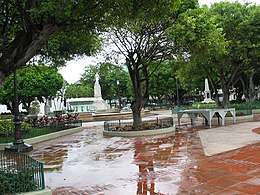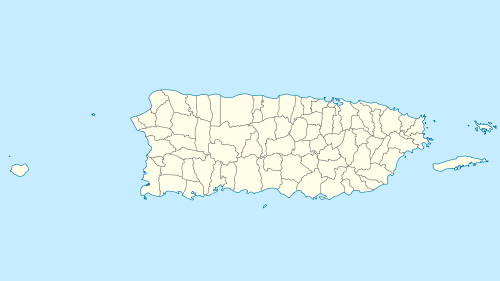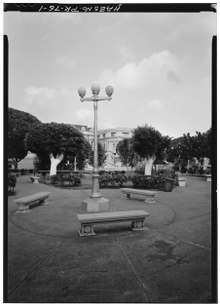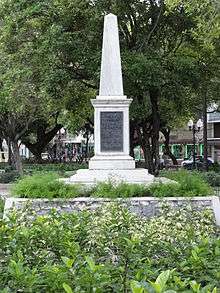Plaza Degetau
| Plaza Degetau | |
|---|---|
 Plaza Degetau, one of two main plazas at Plaza Las Delicias | |
 Plaza Degetau | |
| Type | plaza, urban park |
| Location | Ponce, Puerto Rico |
| Coordinates | 18°00′42″N 66°36′52″W / 18.01167°N 66.61444°W |
| Area | 1.1 acres (0.45 ha) |
| Created | 1670[1] |
| Operated by | Autonomous Municipality of Ponce |
| Visitors | over 200,000[2] |
| Status | Opened all year, 24 hours/day |
Plaza Degetau, formally Plaza Federico Degetau, is the larger of two plazas at Plaza Las Delicias, the main city square in the city of Ponce, Puerto Rico. The other plaza is named Plaza Muñoz Rivera and is located north of Plaza Degetau. The square is notable for its fountains and for the various monuments it contains. The historic Parque de Bombas and Ponce Cathedral buildings are located bordering the north side of this plaza. The square is the center of the Ponce Historic Zone, and it is flanked by the historic Ponce City Hall to the south, the Cathedral and historic firehouse to the north, the NRHP-listed Banco Crédito y Ahorro Ponceño and Banco de Ponce buildings to the east, and the Armstrong-Poventud Residence to the west. The square dates back to the early Spanish settlement in Ponce of 1670. It is the main tourist attraction of the city, receiving about a quarter of a million visitors per year.[3]
History


According to the traditional Spanish colonial custom, a town's main square, or plaza, was the center of the town. In the case of Ponce, a Catholic church was built on the center of the plaza, thus splitting the plaza into two sections.[4] Plaza Degetau is the southern of the two sections, with the other plaza, Plaza Muñoz Rivera, located to the north of Plaza Federico Degetau. Plaza Degetau measures a little over half of 8,800 square meters.[5]
The history of Plaza Degetau dates back to as far as the creation of the first Catholic chapel in Ponce in 1670.[6] It is also known that around 1840 Mayor Salvador de Vives planted trees as a renovation project for plaza.[7] It was first lit in 1864.[8] The Plaza, as it stands today, was designed by architect Francisco Porrata-Doria in 1914.[9]
In addition to the Cathedral and the firehouse, Plaza Degetau at one point also contained an open dining Moorish-style kiosk that had been part of the 1882 Fair Exposition.[10] The kiosk was still present at the time of the American invasion of the island in 1898 as reported by American photo-journalist William Dinwiddie,[11] but it was demolished in 1914.[12]
Name

Legend:
1. Cathedral Nuestra Señora de la Guadalupe
2. Parque de Bombas
3. Lions Fountain
4. Statue of Luis Muñoz Rivera
5. Statue of Juan Morel Campos
6. Statue of Domingo Cruz "Cocolia"
7. Obelisk to "El Polvorin" Firemen
8. Statue of Blind Justice
9. Statue of woman with children, "Maternity"
10 & 11. Large Fountains
Plaza Degetau was originally called Antigua Plaza Real (Old Royal Plaza),[13] and later, Plaza Mayor (Main Plaza).[14] In the early 20th century its named was officially changed to Plaza Federico Degetau, in honor of Federico Degetau, the first Resident Commissioner of Puerto Rico to the United States House of Representatives.
Features
Plaza Degetau is perhaps the best known of the two plazas and the one most often seen in pictures.
Fuente de los Leones
In the center of this plaza lies the famous Fuente de los Leones (Lions Fountain). The large, round-shaped fountain is bounded by a low, marble and granite wall. The fountain's wall boundary is shaped in the form of a regular octagon and built so that one of the vertices of the octagon points towards the historic Ponce City Hall. The fountain also features four lion statues and water that flows under colored lighting effects. The four lion statues are located one statue on each alternating vertex of the fountain's octagonal boundary wall. When obtained, the fountain was adorned with baby angel sculptures, but the angels were replaced by the current (2018) lions. The lions were sculptured by Victor Cott, a sculptor from Juana Diaz in 1940, during the mayoral administration of mayor Andrés Grillasca Salas.[15] The fountain was purchased in 1939 at the New York World's Fair.[16] The fountain, including a mechanical basement, was remodeled and restored in 1993. Its base was enlarged and a computerized lighting system was installed.[17]
The fountain was the inspiration for a poem published in 2002,[18] that reads,
|
|
Juan Morel Campos
This plaza also features a statue of native composer Juan Morel Campos. This statue was produced at the workshop of Italian sculptor Luiggi Tomassi.[19]
Other features
Also in this plaza is an obelisk in honor of the firefighters who fought the "El Polvorín" fire (see Parque de Bombas). The obelisk was unveiled in 1948, in time for the 50th anniversary of the frightful fire.[20]
In the northwest side of the Plaza and facing northwest, there is also a statue, called Blind Justice, of a woman in a long dress with her eyes covered by a cloth wrapped around the top of her head. The woman's left hand holds a sword that sits inside a shaft which rests on the ground, and there are two children sitting happily by her feet: one is embracing the lower part of the sword's shaft and the other child is playing with an orange tree branch. Blind Justice sits on the northwest area of the Plaza and faces northwest.
A second statue, Maternity, sits on the plaza as well. This one consists of a woman sitting down and sitting two small children on her lap, one child sits on her left left and the other one on her right leg, while the children lean against her chest. Maternity sits on the southwest side of the Plaza and faces southwest. These two statues were designed by Victor Cott, a sculptor from Juana Diaz who also designed the four lions at Fuente de los Leones, Esclavo libertado and La Labradora.
La Labradora is a third statue that used to be located on Plaza Degetau, on the southeast section of the Plaza, facing southeast, but today (2018) adorns Parque Graciela Rivera. La Labradora, together with a fourth sculpture yet called El Cuerno de la Abundancia (The Horn of Abundance), were moved out of the Plaza in the late 1940s to make room for the Monumento a los heroes de El Polvorín (1948) and the statue of Juan Morel Campos (~1950), respectively. El Cuerno de la Abundancia was located on the northeast section of the plaza and faced northeast but, in the late 1940s, was relocated to elsewhere in the city of Ponce; unfortunately, it was vandalized at the new location and was lost.[21] The placing of the statues as well as the relocation of the last two statues, occurred during the 16-year mayoral administration of Andrés Grillasca Salas in the 1940s-1950s.
Setting
Plaza Degetau is bounded on the north by the Our Lady of Guadalupe Cathedral and the historic Parque de Bombas firehouse, on the south by Plaza Degetau street (also called Villa street and Comercio street), on the west by Union street, and on the east by Marina street. It is surrounded by two hotels, the Ponce City Hall, two historic banks (Banco de Ponce and Banco Crédito), a long-standing ice cream parlor called "King's Ice Cream", and various boutiques and cafes.[22]
The Plaza has wide mosaic-tile sidewalks, well-manicured flower gardens, well-trimmed bushes and Indian laurel trees, late 1800s lamposts, and numerous marble benches. It is home to the Lions Fountain, "one of the most beautiful fountains in Puerto Rico."[23] The fountain is made of marble and bronze. During the day, the plaza hustles with schoolchildren, shoppers, and tourists. After the sun sets, there are oftentimes live bands giving concerts to "multigenerational families."[24]
Gallery
 Statue of Juan Morel Campos at Plaza Degetau, in 1977
Statue of Juan Morel Campos at Plaza Degetau, in 1977_statue_in_Ponce%2C_PR.jpg) Statue of Domingo Cruz "Cocolia" at Plaza Degetau, in 2010
Statue of Domingo Cruz "Cocolia" at Plaza Degetau, in 2010 Obelisk to El Polvorin firefighters in Plaza Degetau, in 2010
Obelisk to El Polvorin firefighters in Plaza Degetau, in 2010
References
- ↑ Caminata Guiada: Centro Historico de Ponce Archived 2010-03-16 at WebCite
- ↑ Based on the documented number of visitors at the nearby Serralles Castle (See).
- ↑ Based on the documented number of visitors at the nearby Serralles Castle (See).
- ↑ Plaza Las Delicias. Ponce > Ciudad Senorial > Atracciones Turisticas. Official Website of the Government of the Autonomous Municipality of Ponce. Archived 2011-09-07 at the Wayback Machine. Retrieved July 18, 2010.
- ↑ Ramon Marin. Las Fiestas Populares de Ponce. Page 200.
- ↑ Doris Vazquez. Spain in Puerto Rico: Early Settlements. The Yale-New Haven Teachers Institute. 1986. Retrieved November 22, 2009.
- ↑ By Guillermo A. Baralt. Buena Vista: life and work on a Puerto Rican hacienda, 1833-1904. Page 12.
- ↑ Salsa, sabor y control!: sociología de la música "tropical". Ángel G. Quintero Rivera.
- ↑ Architecture of Parish Churches in Puerto Rico. Page 184. Thomas S. Marvel and María Luisa Moreno. University of Puerto Rico. 1993. Retrieved January 8, 2011.
- ↑ 1882-1914 Kiosk
- ↑ Puerto Rico: its conditions and possibilities. William Dinwiddie. New York: Harper and Brothers. 1899. Page 189.
- ↑ Las fiestas populares de Ponce. Page 23. Ramón Marín. 1994. University of Puerto Rico Press. Accessed 19 February 2011.
- ↑ Plaza Las Delicias. Ponce > Ciudad Senorial > Atracciones Turisticas. Official Website of the Government of the Autonomous Municipality of Ponce. Archived 2011-09-07 at the Wayback Machine. Retrieved July 18, 2010.
- ↑ Luis Fortuno Janeiro. Album Historico de Ponce (1692-1963). Page 12. 1963. Imprenta Fortuno. Ponce, Puerto Rico.
- ↑ Nilin Tristani. 20ma. Exaltacion a la Inmortalidad. In, Jardin Juanadino de la Cultura y el Deporte. Government of the Municipality of Juana Diaz, Puerto Rico. 11 December 2005. Page 32.
- ↑ Explore Puerto Rico. By Harry S. Pariser. Page 243.
- ↑ Explore Puerto Rico. By Harry S. Pariser. Page 243.
- ↑ Carmelo Rosario Natal. Ponce En Su Historia Moderna: 1945-2002. Published by Secretaría de Cultura y Turismo of the Government of the Autonomous Municipality of Ponce. Ponce, Puerto Rico. 2003. p. 94.
- ↑ Ponce, the Lordly City: Tourist Attractions. Archived 2011-09-07 at the Wayback Machine.
- ↑ Ponce Municipality of Ponce. Walking Tour: Plaza de las Delicias.
- ↑ Nilin Tristani. 20ma. Exaltacion a la Inmortalidad. In, Jardin Juanadino de la Cultura y el Deporte. Government of the Municipality of Juana Diaz, Puerto Rico. 11 December 2005. Page 32.
- ↑ Frommer's Puerto Rico: Day-by-day. By John Marino. First Edition. Wiley Publishing. 2010. Page 89.
- ↑ Frommer's Puerto Rico: Day-by-day. By John Marino. First Edition. Wiley Publishing. 2010. Page 89.
- ↑ Puerto Rico. By Suzanne Van Atten. Second Edition, September 2009. Page 106.
External links
- Plaza Las Delicias video - featuring the Lions Fountain
- Information about Ponce's touristic places
- Photo of the fountain prior to the Lions Fountain Accessed December 15, 2010.
- Photo of Plaza Degetau in the 1940s with Blind Justice Statue pictured. Retrieved January 5, 2011.
- Photo of Arab kiosk at Plaza Degetau. Retrieved January 8, 2011.
- Photo of Plaza Degetau in the early 1900s, showing the statue of Blind Justice. Retrieved 28 July 2013.
- Photo showing the precursor water fountain to the Lions Fountain at Plaza Degetau
Coordinates: 18°00′40.75″N 66°36′50.15″W / 18.0113194°N 66.6139306°W